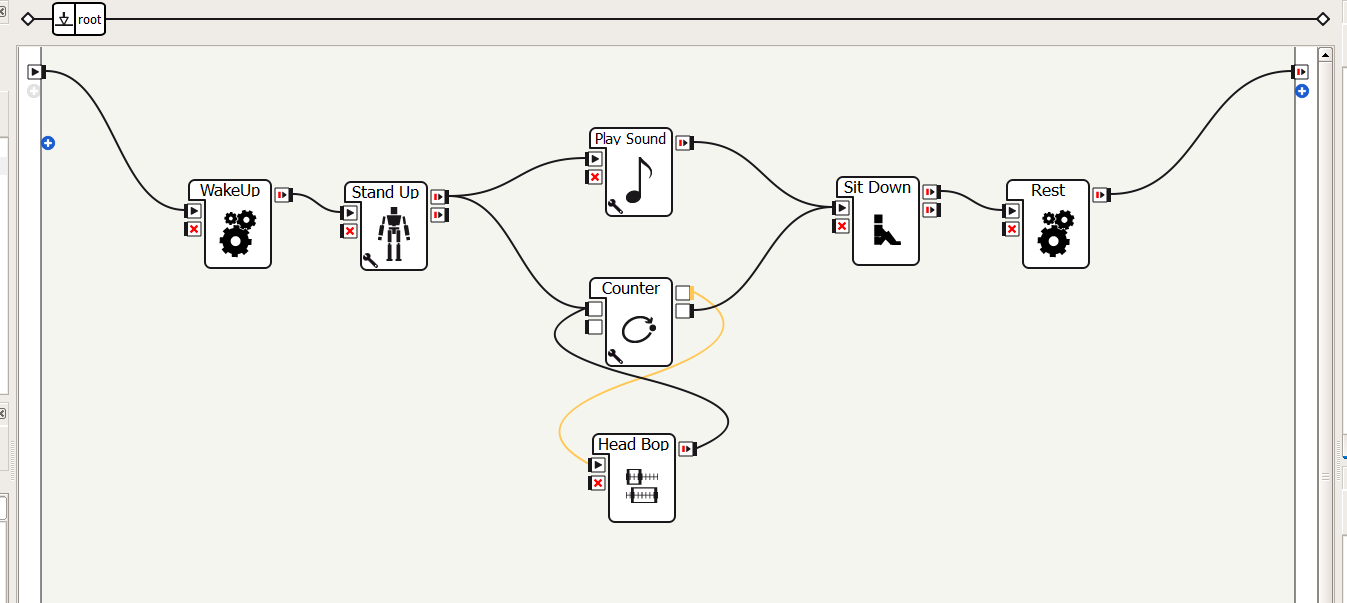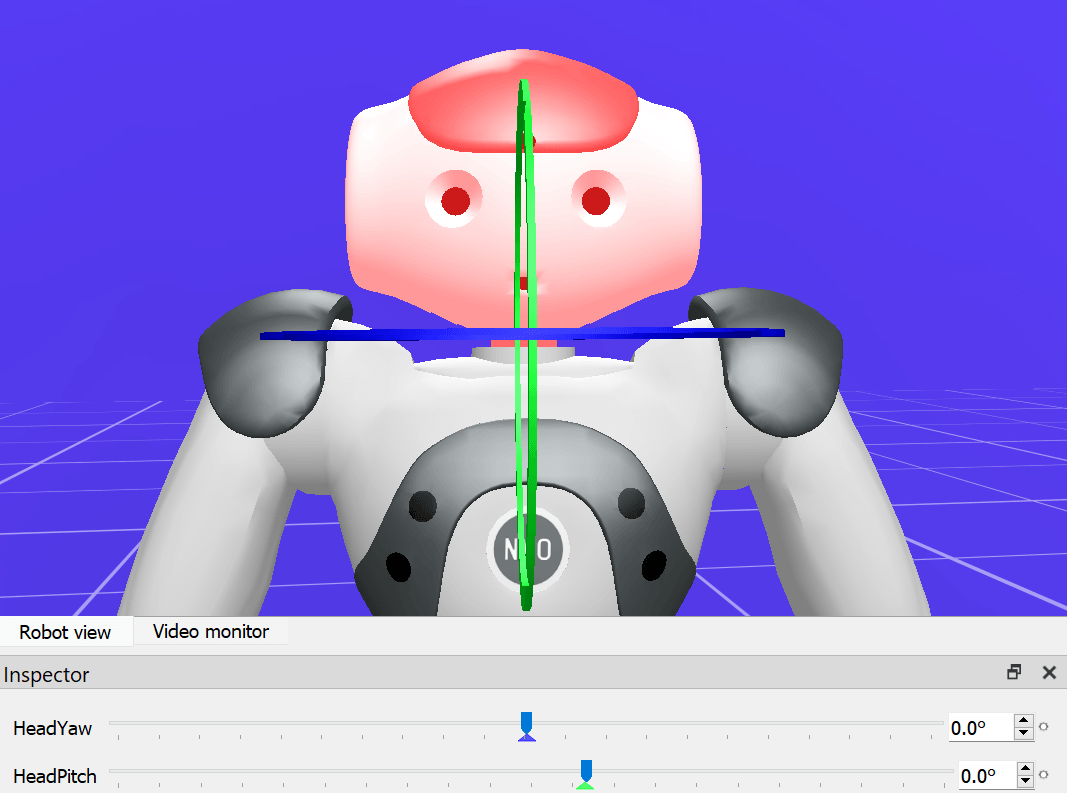Lesson Modules
Teaching Tips:
Bop to the Beat
Problem of the Day:
How can I make NAO move his head to music?
Vocab:
- Timeline
- Frame
- Cycle
- Angle
- Sequence
Students will be able to...
Make the robot’s head move in time to the beat of a song by controlling the specific angle of the head motors.
Content
Students will identify patterns, learn about unit fractions and gain familiarity with negative numbers and angle measures.
Learning Overview:
- Intro: Students will follow NAO in a dance
- Problem Solving: Students will explore how to control the head motors
- Creative Time: - Students will use what they learned to create their own head movement
- Reflection: The class will discuss what they learned and show off their creations
Before the Lesson:
LoadLesson2_1 Choregraphe File onto one of the robots. Give the robot at least 2 feet on all sides to do his dance. Clear a space for students to gather and watch the NAO. They will be mirroring NAO’s movements, so be sure to leave enough space for them to move!
Also, be sure to read the reference sheet for this lesson.
LESSON INTRO
Get the students to stand arms-distance apart. Play the Lesson2_1 Choregraphe File and have the students mirror NAO’s movements.
BEFORE THE CLASS
First, wash your hands. Make this a daily routine. The robots are white and get dirty easily.
OBSERVATION
You will be mirroring NAO's movements, so be sure to clear a space for everyone. Listen carefully what your teacher will explain and follow the direction.
Teaching Tips:
PROBLEM SOLVING
Student Discovery (5 minutes)
Pose the problem of the day to the students. Then have them fill out the “Make a Plan” section. This is a complex problem and we want students to break it apart. They need to know how to
- Control the motions of NAO’s head
- Figure out the timing music beats
- Translate the timing of the music into the software that controls the head movements.
They will do this breakdown mostly on their own, with some prompting from you and your assistants.
Teacher Talk Time (2 minutes)
Explain to students that dances usually have a lot of repetition. You do a particular step over and over again. For that reason, they will learn about looping and different ways to combine patterns.
Angles (5-10 minutes)
Show the students how to control the angles of the head motors (details in reference sheet). Explain that there are two motors that control the position of the head. Demonstrate how they work by moving the head around. Have the students work individually on the “Angles, Angles, Angles” section. After, discuss the angle measures as a class.
Timelines (5-10 minutes)
Next, show the students how to create a timeline box. Tell them that each space in the timeline is a frame and that there are ten frames per second. Have them then fill out the Timeline! page in their student book. Discuss responses as a class. Also, remind the students how to add music to their projects. This should be a refresher from the previous course (Story Telling).

MAKE A PLAN
"I want NAO to move his head to music!"
What do I need to find out?
Draw a picture of what you want NAO to do on a piece of paper.
Relevant boxes
Look for Choregraphe Boxes that might be helpful in solving this problem
ANGLES, ANGLES, ANGLES
Click on the virtual NAO’s head in Robot View to make the pictured window appear. Play with the sliders and answer the questions below. For NOA V6, click on Noa’s head and then open inspector view.
| NAO V4-V5 | NAO V6 |
|---|---|
 |  |
Largest
Draw a picture of NAO with both head angles at their largest value on a piece of paper.
Smallest
Draw a picture of NAO with both head angles at their smallest value on a piece of paper.
Zero
Draw a picture of NAO with both head angles at 0° on a piece of paper.
TIMELINES
When you open a timeline in Choregraphe, the top line is where you will store keyframes (the robot's posture). When you run your program the robot will act out the positions you have stored in this timeline. The timeline is pictured below

Teaching Tips:
CREATIVE TIME
Plan (5-10 minutes)
Have the students break into their dance groups. They will use this time to plan the robot’s head motion for part of their dance. They should fill out the “My Dance” activity. When students feel they have a complete plan, they should have one of the teachers check it over. When you give your approval, the students may move on to use the computers to program their motion.
Implement (15 minutes)
Students will work on programming their planned head motion. They must test their motion on the virtual robot before they are allowed to test it on the real robot. Be sure to sketch the program in the corresponding page at the end of the student book.
See the Lesson2_2 Choregraphe file for an example.
MY DANCE
If this is your sequence,

Then, in choregraphe, you must loop

Even though the cycle length is 2.

Question 1: What is your Pose1?
Question 2: What is your Pose 2?
Question 3: What is your Pose 3?
Teaching Tips:
Reflection (8 minutes)
Have the students fill out the “Reflect” activity. Give them 2 minutes to journal silently. Then have them volunteer their responses to help stem a discussion.
After the Lesson:
- Transfer the students’ Choregraphe files onto the thumb drive and delete the file from the computer.
- Pack up the NAO’s, computers and router.
Question 1: What new boxes did I use today?
Question 2: What do these new boxes do?
Question 3: What did I make NAO do today?
-- next section--
- Transfer your Choregraphe files onto the thumb drive from your teacher and delete the file from the computer.
- Help your teacher packing up the NAO robot computers and router with an extreme care.

